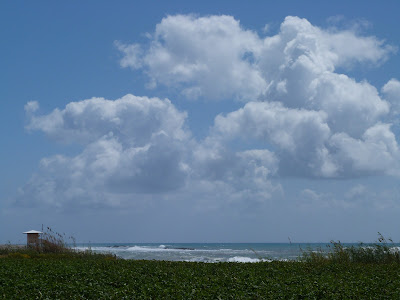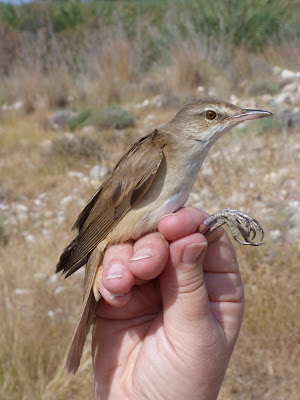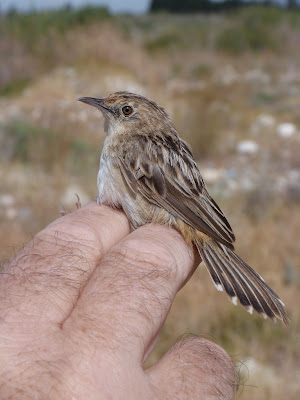Day One - 29 March
The flight got us to Larnaca for early afternoon allowing time for a quick look at the sewage water treatment works and Spiros Pool before heading on to our apartment at Emba.
The roads were quiet, a result of the uncertainty that Cypriots and Ex-pats feel with regard to their money situation- although the bailout has ruled out the 'haircut' to trim savings and deposits under 100,000 Euros.
Highlights included Spur-winged Plover (2), Black winged Stilt (3) and Black Francolin (2 male) at Meneou, Collared Flycatcher (1 male), Spectacled Warbler (2), Kentish Plover (11), Ruppell's Warbler and Red-throated Pipit at Spiros Pool, and Baltic Gull (12), Slender-billed Gull (1), Spur-winged Plover (17), Isabelline Wheatear (2), Pintail (3 male), White and Black-headed Wagtails at the sewage works.
Day Two - 30 March
We began the day with a jaunt in the direction of Latchi to meet an old friend, and pick up the rings. En route we stopped off at a location, not to be disclosed, to check in on a nest site for Bonelli's Eagle. There appeared to be no activity at the nest itself, but we did get a glimpse of a bird working along the ridge, whilst watching the many Cyprus Wheatears and Warblers found at this location.
After meeting Alan for coffee and an annual catch-up, we made our way back to check out our usual ringing haunts. Kouklia was still accessible to the East of the Diarizos and not too overgrown. Achielea now showed no trace of spaces where nets had been placed before and the shingle beach had formed into depressions, developing deeper pools around the reeds. The water escaping to the sea no longer flowed down the beach and this ringing site was effectively lost to us, as was the place West of the Dhiarozis.
The lower pools at Xeros Potamas looked promising, but were wetter than last year and seemed to be subject to more disturbance so we shall have to monitor the site and see how it goes.
There was also an Olivaceous along with supporting cast of Sardinean Warbler, Cetti's Warblr and Spanish Sparrow.
The flight got us to Larnaca for early afternoon allowing time for a quick look at the sewage water treatment works and Spiros Pool before heading on to our apartment at Emba.
The roads were quiet, a result of the uncertainty that Cypriots and Ex-pats feel with regard to their money situation- although the bailout has ruled out the 'haircut' to trim savings and deposits under 100,000 Euros.
Highlights included Spur-winged Plover (2), Black winged Stilt (3) and Black Francolin (2 male) at Meneou, Collared Flycatcher (1 male), Spectacled Warbler (2), Kentish Plover (11), Ruppell's Warbler and Red-throated Pipit at Spiros Pool, and Baltic Gull (12), Slender-billed Gull (1), Spur-winged Plover (17), Isabelline Wheatear (2), Pintail (3 male), White and Black-headed Wagtails at the sewage works.
Day Two - 30 March
We began the day with a jaunt in the direction of Latchi to meet an old friend, and pick up the rings. En route we stopped off at a location, not to be disclosed, to check in on a nest site for Bonelli's Eagle. There appeared to be no activity at the nest itself, but we did get a glimpse of a bird working along the ridge, whilst watching the many Cyprus Wheatears and Warblers found at this location.
After meeting Alan for coffee and an annual catch-up, we made our way back to check out our usual ringing haunts. Kouklia was still accessible to the East of the Diarizos and not too overgrown. Achielea now showed no trace of spaces where nets had been placed before and the shingle beach had formed into depressions, developing deeper pools around the reeds. The water escaping to the sea no longer flowed down the beach and this ringing site was effectively lost to us, as was the place West of the Dhiarozis.
The lower pools at Xeros Potamas looked promising, but were wetter than last year and seemed to be subject to more disturbance so we shall have to monitor the site and see how it goes.
This flock routinely crossed the river bed to find fresh water and grazing.
Mandria, a birding hot spot, was much the same except for a new life guard hut on the beach and an ominously cleared area in what we think of as the wheatears' sandpit.
Mandria fields and beach
Best birds of the day were Bonelli's Eagle, Great Spotted Cuckoo, Cyprus Warblers 3 male/1 female, Cyprus Wheatear, Nightingale, Rock Dove and Little Owl in the Koloni area, with a Hawfinch, Lapwing, Hoopoe (2), Black-eared Wheatear(2) and Short-toed Lark (8) at Mandria. Xeros Potamas pools gave us Greenshank (1), Green Sandpiper (7), Wood Sandpiper (2), Little Stint (1), Little Egret (2), Serin (2) and male and female Citrine Wagtails.
Wood Sandpiper on Xeros Potamas lower pools
Day Three - 31 March
Our early start, 5.30am, seemed barely early enough as it seemed to have been light a fair while by the time we arrived and got nets set up at Kouklia. The first bird out of the nets was a Savi's Warbler.
Savi's Warbler
There was also an Olivaceous along with supporting cast of Sardinean Warbler, Cetti's Warblr and Spanish Sparrow.
Olivaceous Warbler
Spanish Sparrow
The car served as our mobile ringing station
We saw a few migrants about and caught 20 birds. We were also treated to Swallowtail, Paphos Blue and Clouded Yellow butterflies fuelling up on the yellow and purple flowers. Other bird sightings included Purple Heron (3), Buzzard (1) and an extremely nervous and cautious Song Thrush disappearing swiftly into cover.
Ringing Totals: 20
Cetti's Warbler - 2
Savi's Warbler - 1
Sedge Warbler - 1
Olivaceous Warbler - 1
Sardinian Warbler - 4
Blackcap - 5
Lesser Whitethroat - 1
Great Tit - 1
Chiffchaff - 1
Spanish Sparrow - 3
Ringing Totals: 20
Cetti's Warbler - 2
Savi's Warbler - 1
Sedge Warbler - 1
Olivaceous Warbler - 1
Sardinian Warbler - 4
Blackcap - 5
Lesser Whitethroat - 1
Great Tit - 1
Chiffchaff - 1
Spanish Sparrow - 3
The second part of the day was donated to finding and exploring the deserted village of Trozena. As well as seeing Long-legged Buzzard, Great Spotted Cuckoo and Red-rumped Swallow, the butterflies included Estern Festoon, Cleopatra, Orange Tip, Red Admiral, Swallowtail and Clouded Yellow around the Neopolian Garlic flowers.
Great Spotted Cuckoo
Napoleon Garlic
Deserted village of Trozena
Eastern Festoon
The rather magnificently named Wavy-leaved Monkey Orchid
The lower pools at Xeros Potamas, visited at the end of the day, held the expected waders with the bonus of a Bittern seen in flight at dusk.
Day Four - 1 April
A day spent birding from the car at the local sites. Starting with Acheliea we saw Buzzard (1), Kingfisher (1), Little Egret (1), Whinchat (2), Wheatear (1) and Black Francolin (1 male).
Achielea
Moving on to Agia Varvara we drove down from the main road to look across the river and fields, and search the soak aways, proven to attract migratory birds in need of water. We were pleased to see Alpine Swift (4), Buzzard (1), Great Spotted Cuckoo(1), Purple Heron (1) and Hoopoe (1). While watching the soak away tanks a Baillon's Crake (1) was seen with some Little Crakes(2 male and 1 female).
Agia Varvara soak away tank
Male Little Crake male creeping along the tank margins
A tour of Anarita Park turned up Tawny Pipit (c45), our first Wryneck (1), Wheatear (8), Tree Pipit, Lesser Kestrel (2 female), Isabelline Wheatear (1), Whitethroat (1) and Whinchat (1).
Whinchat
Mandria produced Short-toed Larks (circa 25) foraging on the freshly ploughed arable fields.There were few other passerines about with only singles of Isabelline Wheatear and Water Pipit seen but we did well for harriers with Hen Harrier (1 male),Marsh Harrier (1 male) and Pallid Harrier (1 female) seen quartering the fields.
Mimosa in bloom
The last visit was Xeros Potamas pools. In addition to the birds in the main bed, several were enjoying a small muddy pool, that looked and smelled as though slurry from the sheep sheds was
seeping down from above. The Little Ringed Plover were at circa 20 birds, Black-winged Stilt (3), Little Egret (1), Hoopoe (1), Cattlre Egret (3), Little Stint (2), Green Sandpiper (10, Wood Sandpiper (5), Greenshank (1), Ruff (4), Citrine Wagtail (1 female), Glossy Ibis (2), Masked Shrike (1) and Sedge Warbler(1).
Hoopoe
Glossy Ibis
Day Five - 2 April
A second day ringing at Kouklia brought a steady trickle of birds. An increase in temperature and this was the only day that saw basking lizards skittering away as we went on the net rounds.
Lacerta Laevis Lizard
Among the species caught (and expected) in such habitat were Sedge Warbler,Great Reed Warbler, Sardinian Warbler
Sedge Warbler
Great Reed Warbler
Male Sardinian Warbler
But this unusual bird (ring number 010 16752) was in full wing moult and displayed brown tones throughout. Precise identity is to be researched and hopefully confirmed at a later stage pending consultation. We think we know its identity. Any ideas?
Ringing Totals: 19 (4)
Cetti's Warbler - 1 (2)
Sedge Warbler - 3
Great Reed Warbler - 2
Oliviaceous Warbler - 1
Sardinian Warbler- 2 (2)
Blackcap - 8
Lesser Whitethroat - 1
CC sp - 1
The afternoon was spent doing a round of the usual sites. At the lower Xeros Potamas pools we had what had become the usual sightings and our first Squacco Heron of the trip. The female Citrine Wagtail was still present.
At Asprokremnos Dam we saw a Woodchat Shrike (1),Tawny Pipit (4) and Cormorant (1). A drive along the top of the dam itself turned up a female Black-eared Wheatear and some Northern Wheatear (7). Timi forest revealled Whinchat (1) and Wheatear 4) although there is always the inkling that the dense vegetation and eucalyptus stands hide more than can be seen. At Mandria a port-a-cabin had appeared at one end of the sandpit. The Lapwing remained in its favoured field while a Spur-winged Plover and male Merlin were also present.Wheatear (18) had been dropping in. Baltic Gull (2) and Spoonbill (10+) went by on the sea.
Day Six - 3 April
This day will go down as one of our more memorable days of the holiday. Firstly because we saw lots of good birds on our visit to Akrotiri and secondly because we were denied access to a spot close to Zakaki as it wasa murder crime scene. We have often joked that Chris or the pair of us might one day happen across a body when visiting a lonely and secluded spot- but were happy not to be the first to make the grisly discovery of the body in a burnt out car.
The day started well at Phassouri Reedbed with a female Bluethroat in an area of recently burnt off reeds, in addition to birds seen over the wet area around the main reedbed, including Snipe (4) and Pallid Harrier (1 female).
Phassouri Reedbed
Moving on to Akrotiri Gravel Pits we acquired a decent list that included Ruppell's Warber (2), Woodchat Shrike (4), Kentish Plover (5), Redstart (1), Nightingale (1),Sandwich Tern (4) and Short-toed Lark (circa100).
Akrotiri old church and garden (where we saw Redstart and Nightingale)
Short-toed Lark
We tried Bishop's Pool in the hope of seeing the White-breasted Kingfisher - but failed! But did see Eastern Bonelli's Warbler (2), Cuckoo (1), Gargany (1), Ferruginus Duck (1) and Montagu's Harrier
(1 female) among other sightings.
Bishop's Pool
Agama Lizard
The pools at Ladies Mile were very full, holding good numbers of Little Stint and Kentish Plover with Wood Sandpiper (4), Greenshank (9) and Ruff (77).
Little Stints feeding up on Ladies Mile.
Sea Lavendar
A circuit around the perimeter fence of the antenae was worth a look and held Wheatear (8), Eastern Bonelli's Warbler (1),Hoopoe (2), Woodchat Shrike (1) and Rock Thrush(1 male).
Male Rock Thrush
While viewing the Akrotiri Salt Lake Water Pipit (1), Spectacled Warbler (1),Marsh Sandpiper (1) Great Snipe (1), Curlew Sandpiper (1), Greater Flamingo and Collared Pratincole (3) were of particular interest
Salt lake margins at marsh outflow.
Day Seven - 4 April
After a severe storm that woke us at 1am or so and persistent conversation (in Russian) from 4 to 5am, we were up ahead of the alarm to get some ringing in before forecat rain shoers set in. These showers are very heavy and can soak you through in minutes, but at least the strong winds and sunshine usually have you dry before the next drenching. Conditions were tough and numberss low but star captures were Zisting Cisticola and Subalpine Warbler. A Blue-cheeked Bee-eater overhead was picked up (by D) on cal, and having flown up the river valley, returned to bathe in the Diarizos, rendez vous with a second bird and disappear in the direction of the sea.
Zisting Cisticola
Subalpine Warbler male
Blue-cheeked Bee-eater drying off after freshening up
Ringing Totals: 11 (2)
Fan-tailed Warbler - 1
Cetti's Warbler - 0 (1)
Subalpine Warbler - 1
Sardinian Warbler - 2 (1)
Lesser Whitethroat - 2
Blackcap - 3
Whitethroat - 1
Chiffchaff - 1
The first Turtle Dove of the trip was recorded at Kouklia. A visit to the pool at Kouklia Fish Farm showed that Black-winged Stilt (1), Green Sandpiper (2), Common Sandpiper (1), Kingfisher (2), Sedge Warbler and Citrine Wagtails (1 male/1 female) are using the small pool. At Aspro Dam Night Heron (16) were disturbed while resting in conifers above the dam and went up. Gargany (1), Marsh Harier (1) Black-eared Wheatear (2) and Whitethroat (1) were also seen.
At Xeros Potamos the numbers were on the increase with numbers as follows: Little Egret (8), Squacco Heron (4), Glossy Ibis (15), Black-winged Stilt (30) and Little Stint (15).
Black-winged Stilts at Xeros Potamas lower pools






































